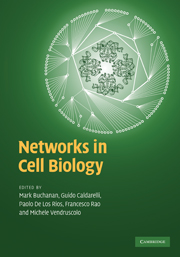Book contents
- Frontmatter
- Contents
- List of contributors
- Introduction
- 1 Network views of the cell
- 2 Transcriptional regulatory networks
- 3 Transcription factors and gene regulatory networks
- 4 Experimental methods for protein interaction identification
- 5 Modeling protein interaction networks
- 6 Dynamics and evolution of metabolic networks
- 7 Hierarchical modularity in biological networks: the case of metabolic networks
- 8 Signalling networks
- Appendix A Complex networks: from local to global properties
- Appendix B Modelling the local structure of networks
- Appendix C Higher-order topological properties
- Appendix D Elementary mathematical concepts
- References
- Index
Appendix B - Modelling the local structure of networks
Published online by Cambridge University Press: 05 June 2012
- Frontmatter
- Contents
- List of contributors
- Introduction
- 1 Network views of the cell
- 2 Transcriptional regulatory networks
- 3 Transcription factors and gene regulatory networks
- 4 Experimental methods for protein interaction identification
- 5 Modeling protein interaction networks
- 6 Dynamics and evolution of metabolic networks
- 7 Hierarchical modularity in biological networks: the case of metabolic networks
- 8 Signalling networks
- Appendix A Complex networks: from local to global properties
- Appendix B Modelling the local structure of networks
- Appendix C Higher-order topological properties
- Appendix D Elementary mathematical concepts
- References
- Index
Summary
Introduction
In this appendix we review various theoretical models that have been proposed in order to reproduce some of the empirically observed properties of real networks. We consider only the models that focus on the local topological properties, in particular (in the language of Appendix A) on the first- and second-order properties. As a result, the higher-order properties of the networks generated by the models considered here are the result of local rules alone. Nonetheless, suitable local rules are often enough in order to reproduce most of the observed complexity of real networks. Moreover, it is believed that most real networks are indeed shaped by local rules alone, as higher-order mechanisms requiring the knowledge of the entire network are in most cases unfeasible.
The models presented here share a common aspect: the deviation of real networks from regular graphs is modelled through the introduction of some ‘disorder’ according to suitable stochastic rules. All the models described below (and largely most models in the literature) are therefore stochastic models. As a consequence they are also ensemble models, since they define a whole set of possible realizations of a network, rather than a single graph. Ensemble averages give the expected value of any topological property. They will be denoted by angular brackets 〈…〉 to avoid confusion with averages over the vertices of a single graph, which are instead denoted by a bar as in Appendix A.
Information
- Type
- Chapter
- Information
- Networks in Cell Biology , pp. 188 - 209Publisher: Cambridge University PressPrint publication year: 2010
